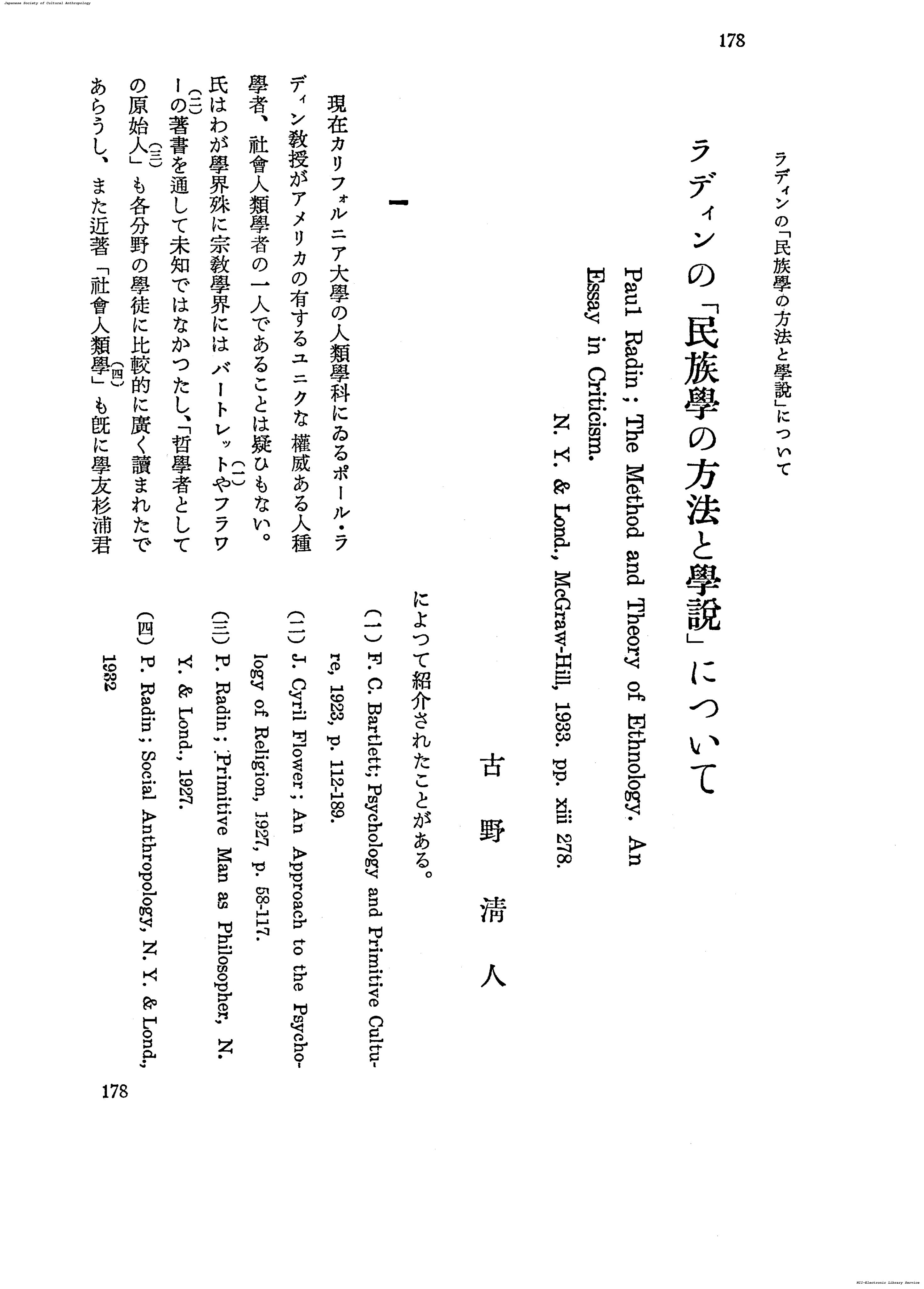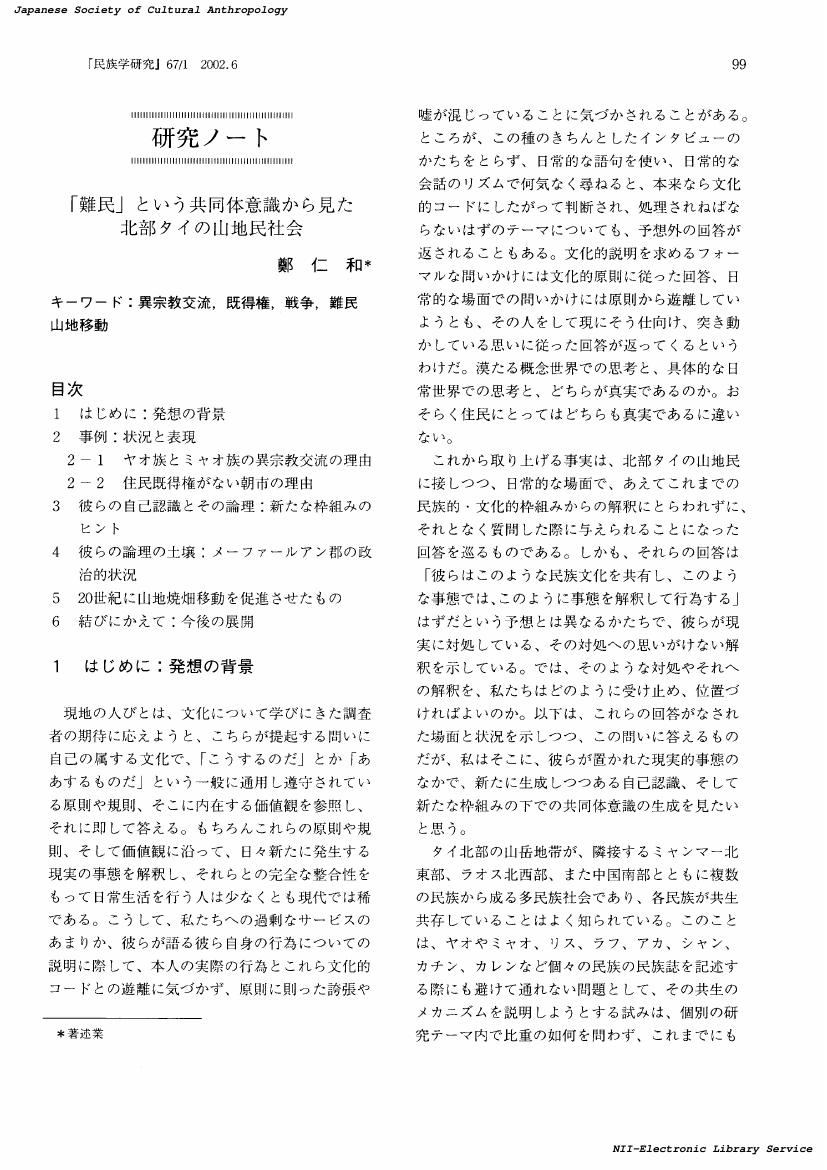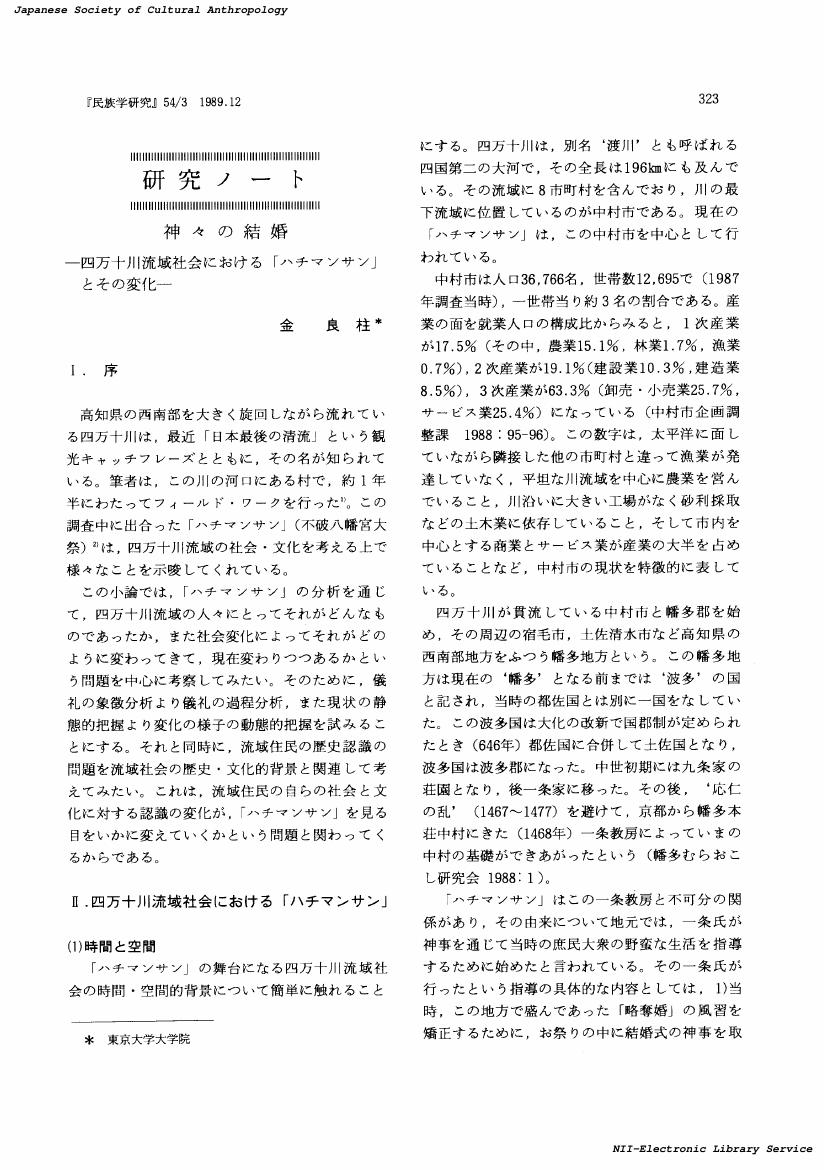1 0 0 0 OA ラディンの「民族學の方法と學説」について
- 著者
- 古野 清人
- 出版者
- 日本文化人類学会
- 雑誌
- 民族學研究 (ISSN:24240508)
- 巻号頁・発行日
- vol.1, no.1, pp.178-184, 1935-01-01 (Released:2018-03-27)
1 0 0 0 OA 高砂族の系譜
- 著者
- 馬淵 東一
- 出版者
- 日本文化人類学会
- 雑誌
- 民族學研究 (ISSN:24240508)
- 巻号頁・発行日
- vol.1, no.1, pp.1-16, 1935-01-01 (Released:2018-03-27)
1 0 0 0 OA ダーデキー・サールハープールの宗教生活 (2) : 北インド農村の祭りと伝統的宗教生活
- 著者
- 佐々木 明
- 出版者
- 日本文化人類学会
- 雑誌
- 民族學研究 (ISSN:24240508)
- 巻号頁・発行日
- vol.46, no.1, pp.18-34, 1981-06-30 (Released:2018-03-27)
1 0 0 0 OA ケニア・カンバにおけるウイッチ
- 著者
- 上田 将
- 出版者
- 日本文化人類学会
- 雑誌
- 民族學研究 (ISSN:24240508)
- 巻号頁・発行日
- vol.39, no.4, pp.324-336, 1975-03-31 (Released:2018-03-27)
The purpose of this paper is to give a brief account of Kamba witches (aoi, sing. muoi) . This paper is based on field work done in the Kyuso Division, the northern part of Kitui District, Kenya, from December 1970 to July 1973. People say they can find witches in every village. They fear witches very much. They don't want to marry the daughters of witches. Therefore, witches' daughters usually marry poor men with few cattle. The bride-wealth paid for a witch's daughter is less than normal. The characteristics of witches described include : (1) Witches are all women and their magical power (uoi or woman's uoi, uoiwa mundu muka) is inherited through the female line by doing a specific ritual in which mother and daughter join and shake their buttocks together, chanting a spell. Witches' sons do not inherit uoi at all. They are not regarded as witches. Kamba witchcraft is deeply involved with femininity. (2) Witches do not use any magical medicines (miti, ndawa) or fetishes (ithitu) . People explain that witches hide these kinds of things. Witches bewitch people by just scratching their buttocks or saying some suggestive words such as "You will see later." Witches' magical power originates from the inside of their bodies, especially their genital organs, not from medicine men or others. (3) It is believed that witches cause people many kinds of misfortunes such as disease, wounds, sterility, death, and loss of work. Witches can also cause 'disease, death, and sterility among livestock and the destruction of crops.
1 0 0 0 OA 第10回国際人類学民族学会議とインドの人類学
- 著者
- 佐々木 明
- 出版者
- 日本文化人類学会
- 雑誌
- 民族學研究 (ISSN:24240508)
- 巻号頁・発行日
- vol.44, no.2, pp.197-201, 1979-09-30 (Released:2018-03-27)
1 0 0 0 OA 供犠される娘・産む母神; 輪島の二つの祭礼
- 著者
- 林 勲男
- 出版者
- 日本文化人類学会
- 雑誌
- 民族學研究 (ISSN:24240508)
- 巻号頁・発行日
- vol.50, no.4, pp.408-423, 1986-03-31 (Released:2018-03-27)
1 0 0 0 OA 民族医療の領有について(<特集>民族医療の再検討)
- 著者
- 池田 光穂
- 出版者
- 日本文化人類学会
- 雑誌
- 民族學研究 (ISSN:24240508)
- 巻号頁・発行日
- vol.67, no.3, pp.309-327, 2002-12-30 (Released:2018-03-27)
- 被引用文献数
- 1
先住民社会に存在している薬草や治療技術の総体としての民族医療を、グローバルな資本主義の流通形態から解放する。これが本論文の目的である。人類が享受している医薬品の多くが先住民における利用にもとづくものであったことは自明の事実であるが、今日では歴史上の逸話にとどまり、人類全体が受けてきた便益に対する償還が検討されることは稀である。この理由を、筆者は近代医療の確立とともに生起した民族医療的知識の独自性と見なされている「非近代医療的性格」の主張であると考え、この主張が近代医療に付与されている知的財産権の概念を民族医療に付与しなかった根拠になったと考える。民族医療は、土地固有の知識と実践の体系であるという説明は、薬草が薬局方として成立したり、その有効性が近代医療によって証明されるという近代医療との相互交渉という歴史的証拠から、立論の限界が生じる。また近代医療は、民族医療の要素を取捨選択しながら領有することで、医療概念を確立してきた経緯ゆえに、近代医療そのものが民族医療に対して排他的な知的独立性を主張することにも限界が生じる。それゆうに民族医療の知識形態を知的財産として捉える立論の可能性を検討する必要が生じる。近代医療は民族医療を領有することを通して人類に便益をもたらしてきたという事実を認め、これまでの知的所有権に関する報酬の概念を拡張しつつ、その償還に関する方法が提案されてきた。人類学諸理論が、これらの実践的問題に対する法的および社会的整備に寄与する可能性は大きい。
- 著者
- 重信 幸彦
- 出版者
- 日本文化人類学会
- 雑誌
- 民族學研究 (ISSN:24240508)
- 巻号頁・発行日
- vol.65, no.4, pp.344-361, 2001-03-31 (Released:2018-03-27)
- 被引用文献数
- 1
本稿は,昭和初期に主に印刷メディア上で「愛国美談」として喧伝された,日露戦争時の出来事をめぐって語られた「久松五勇士」の成立と展開を検討し、「沖縄」という場所が近代「日本」のどのような視線により語られ意味づけられたか,その政治的布置を歴史的に考察するものである。それは,近代「日本」を覆う印刷メディア群のなかを,一つの「話」が様々に文脈化されて流通するさまを通して民俗話を構成する試みでもある。まず,「美談」の素材となった歴史的逸話が,本土から赴任した国語教師に再発見され,それが中等学校用「国語読本」の教科書に教材として掲載されて全国的に流布した「美談」化の過程から,そこに,「沖縄」を覆う近代「日本」の「国語」という制度が介在していることを指摘した。さらに,この「美談」の素材なった逸話を再発見した国語教師は,「沖縄の土俗」にも興味を示し,それを積極的に喧伝していた。「沖縄」に注がれた,「美談」を発見する視線と「土俗」を対象化する視線は,ここでは極めて近い位置にあった。また,こうして「日本」という文脈をあたえられた「五勇士」は,「沖縄」生まれの研究者たちにより、昭和初期の「郷土沖縄]を語る場に取り込まれ、「沖縄」の自画像を描く要素の一つとして位置づけられる。そこには近代「日本」のナショナリズムと,「沖縄」で描き出される自画像の共犯関係を見出すことができる。そして,昭和初期に「日本」のなかの「沖縄」の「美談」として喧伝された「久松五勇士」は, 1980年代に,宮古島の久松が与那覇湾の淡水湖化計画に対する反対運動を組織していくなかで,今度は久松の「海」と「漁師の魂」を象徴するものとして再解釈されることになる。そこに,地域の結集のために既成の「美談」を脱文脈化し再利用していく,したたかな戦術を見出すことができるのである。
1 0 0 0 OA 「難民」という共同体意識から見た北部タイの山地民社会
- 著者
- 鄭 仁和
- 出版者
- 日本文化人類学会
- 雑誌
- 民族學研究 (ISSN:24240508)
- 巻号頁・発行日
- vol.67, no.1, pp.99-110, 2002-06-30 (Released:2018-03-27)
1 0 0 0 OA 古代中国の射礼
- 著者
- 伊藤 清司
- 出版者
- 日本文化人類学会
- 雑誌
- 民族學研究 (ISSN:24240508)
- 巻号頁・発行日
- vol.23, no.3, pp.185-202, 1959-07-25 (Released:2018-03-27)
Among the materials of ancient China, especiary among the Inscriptions of Bronze Vessels (金文) of Western Chou Dynasty (西周), we have found a number of records that tell us that the Emperor of China (天子) often shot water-birds and fishes personally at the Holy Pond (辟雍) in the suburbs of the capital. (〓〓Yu-Kuei;麦尊Mai-Tsun;礼記・月令Li-Chi・Yueh-Ling etc.) This custom originally came from the religious belief that spring would come earlier if game were offered af the end of winter. In国語・魯語(Kuo-Yu・Lu-Kuo) it states, "In the end of the coldest season, the officers of fushery hunted big fishes and water-birds and prayed to gods sacrificing them for easier coming of spirng". People thought water-birds and fishes were spirits of spring, as they would appear with the coming of spring. And this belief was connected with the divination which foretold whether the year would be abundant or meager by the amount of game. In Shih-Chin (詩経) people sang, "Men divine by fishing to see whether they will have an abundant harvest or not." (小雅・無羊; Hsiao-Ya・Wu-Yang) By the Inscriptions of Bronze Vessels of Western Chou Dynasty, we know that the rites of the personal cultivation (籍田) and of shooting were performed together by the Emperor. (令鼎, Ling Ting) And when the Emperor, the supreme ruler of the whole country, performed this shooting ritual, the year's crop for the whole country was forecast at the same time. So, the ritual was a very responsible business for him, and was performed very impressively. Hence we know that the shooting ritual as an annual act of divination came to be related with the agricultural ritual. But later it was celebrated not only with the agricultural ceremony but also with various kinds of rituals and the game which had been shot down then were dedicated to gods. The shooting ritual had gradually lost its original meaning and changed into a kind of symposium for praying gods with offering game. Often there people ate the offerings and swore each other by gods. On the other hand, people also prayed to the gods by shooting wild beasts, such as bears, deers and tigers etc., above the ground. We have already noted that there was such a ceremony in Yin Dynasty (殷代) on the Inscriptions of Bone (甲骨文) and I think that its significance was similar to the above-mentioned. Keeping step with the change in the meaning, the shooting ritual had changed greatly in its form. In the later half of Western Chou Dynasty, it became obsolete for the Emperor to shoot personally at the Holy-Pond. It was performed at some shooting range (〓,〓,序) which was set near by the Pond. And there the Emperor himself did not shoot game any longer, but his subjects competed in the shooting with each other for the prize which would be given by His Majesty. (〓曹鼎,Hsi-Ts'ao-Ting;師湯父鼎, Shih-T'ang-Fu- Ting;礼記・射義, Li-Chi・She-I) In this competition, however, we heve found some traces of the old custom. They used the target of canvas with the hide or the picture of a bear, deer or tiger on it. In some cases, people called the target by the name of Hu (鵠) or Hou (候). Hu (鵠) is the name of a water-bird. But Hou (候) means usually a feudal lord (候). Therefore some people have said that the purpose of the Shooting ritual was to punish the bad feudal lord and that the Emperor made his subjects shoot the target which represented the evil lord and therefore the target was named after候(Hou). (cf.陳槃"候与射候"; Ch'en-P'an "Hou and Shooting the Target") But I believe候was originally the name of a bird 鴻(Hung) and then the target (Hou) itself was modelled after the bird that was a object to be shot in the early period.
1 0 0 0 OA 釜石市平田村の社会構造と宗教(日本民族学会第 9 回研究大会報告要旨 (1))
- 著者
- 高瀬 武三
- 出版者
- 日本文化人類学会
- 雑誌
- 民族學研究 (ISSN:24240508)
- 巻号頁・発行日
- vol.35, no.3, pp.226-227, 1970-12-31 (Released:2018-03-27)
1 0 0 0 OA 日本における双分制 : 特に祭を中心として
- 著者
- 北原 真智子
- 出版者
- 日本文化人類学会
- 雑誌
- 民族學研究 (ISSN:24240508)
- 巻号頁・発行日
- vol.21, no.3, pp.207-212, 1957-08-25 (Released:2018-03-27)
1 0 0 0 OA 群馬県Y部落における憑きものと社会構造
- 著者
- 吉田 禎吾 板橋 作美
- 出版者
- 日本文化人類学会
- 雑誌
- 民族學研究 (ISSN:24240508)
- 巻号頁・発行日
- vol.40, no.2, pp.146-150, 1975-09-30 (Released:2018-03-27)
1 0 0 0 OA オロッコ・ギリヤークの衣食住
- 著者
- 宮本 馨太郎
- 出版者
- 日本文化人類学会
- 雑誌
- 民族學研究 (ISSN:24240508)
- 巻号頁・発行日
- vol.22, no.1-2, pp.5-14, 1958-03-25 (Released:2018-03-27)
The Japanese Society of Etlmology held a tour of investigation during the period of July and August, 1938 for the purpose of surbeying the culture of the Northern peoples. It was the secood tour for the same purpose. The members of the tour were divided into two groups. The one was of ethnology and the other was of archaeology. The writer of this reoport joined the formaer group with Prof. Kiyoto Furuno (古野清人) and Prof. Akiyoshi Suda (須田昭義) and engaged in an anthropological and ethnological investigation into the aborigines of Saghalien (Karafuto) including the Oroks, the Gilyaks, and the Ainu of the west coast of the island. During the tour, se collected various kinds of tools used by these aborigines and filmed their every bay life with a 16m/m camera. The report here by introduced in the Japanese language is the writer's note on the above-mentioned matters used when he made an address at the meeting of The Minzokugaku Kenkyujo (The Ethnological Research Institute), an affiliated organization to The Japanese Society of Ethnology, held in May 1939. The note was made according to the talks given some Orakan menand women at Shisuka-Machi (敷香) including Washiraika (Wakichi Kitagawa, a man of 41 years old as of 1938) and an interview with Mr. and Mrs. Kawamura (川村秀弥) who were, at that time, working as the teachers at the Otasu Aborigines, Primary Schoo1. The writer's note covers the matters about the things that are necessary for their everyday life such as clothing, cooking, housing, fishing and hunting. There were many matters which would have been written in the note and were left out. Such matters will be introduced some other time. The writer is much in debted to Mr. Jiro Ikegami (池上二良), a linguist in representing the Orokan dialect in phonetic signs and appending notes to this report.
1 0 0 0 OA リンチン博士のモンゴル伝承研究(資料と通信)
- 著者
- 田中 克彦
- 出版者
- 日本文化人類学会
- 雑誌
- 民族學研究 (ISSN:24240508)
- 巻号頁・発行日
- vol.27, no.3, pp.603-605, 1963 (Released:2018-03-27)
1 0 0 0 OA 文化相対主義の困難を超えて
- 著者
- 関根 康正
- 出版者
- 日本文化人類学会
- 雑誌
- 民族學研究 (ISSN:24240508)
- 巻号頁・発行日
- vol.62, no.2, pp.181-183, 1997-09-30 (Released:2018-03-27)
1 0 0 0 OA 高麗朝歴代妃・嬪の姓の継承に関する一試論 : 同姓不婚制の形成過程における一現象の究明
- 著者
- 李 熙永
- 出版者
- 日本文化人類学会
- 雑誌
- 民族學研究 (ISSN:24240508)
- 巻号頁・発行日
- vol.31, no.1, pp.28-37, 1966-06-30 (Released:2018-03-27)
- 著者
- 松前 健
- 出版者
- 日本文化人類学会
- 雑誌
- 民族學研究 (ISSN:24240508)
- 巻号頁・発行日
- vol.29, no.1, pp.71-74, 1964-08-31 (Released:2018-03-27)
- 著者
- 金 良柱 中村 孚美
- 出版者
- 日本文化人類学会
- 雑誌
- 民族學研究 (ISSN:24240508)
- 巻号頁・発行日
- vol.54, no.3, pp.323-330, 1989-12-30 (Released:2018-03-27)
- 著者
- 島 五郎 木村 邦彦
- 出版者
- 日本文化人類学会
- 雑誌
- 民族學研究 (ISSN:24240508)
- 巻号頁・発行日
- vol.16, no.3-4, pp.280-283, 1952 (Released:2018-03-27)
アイヌ指紋各型の出現頻度は(1)総数に就いては尺側蹄状状が多く, 渦状紋が少なく, (2)隻手に就いては, 他の多くの人種と異なって, 左手より右手に尺側蹄状紋が多く, 渦状紋が少ない。この特徴は他人種に類例の稀なアイヌ指紋の特異点である。撓側蹄状紋も左手に比して右手に特に少なく現われる。以上の如き特異点を有するアイヌと和人-(1)総数に対する頻度はアイヌに比して尺側蹄状紋が少なく, 渦状紋が多く, (2)隻手に就いては男性では右手に尺側蹄状紋が少なく, 渦状紋多く, 女性では尺側蹄状紋と渦状紋が左右の手に略相半ばして現われ, 明らかにアイヌと異った特徴を有する和人-との第一代雜種の指紋は(1)総数に就いての頻度はなお強くアイヌ的特徴を有っているが, (2)隻手に現われる指紋各型の頻度には和人的特徴が強く見られるようである。(昭.26.11.8記)













